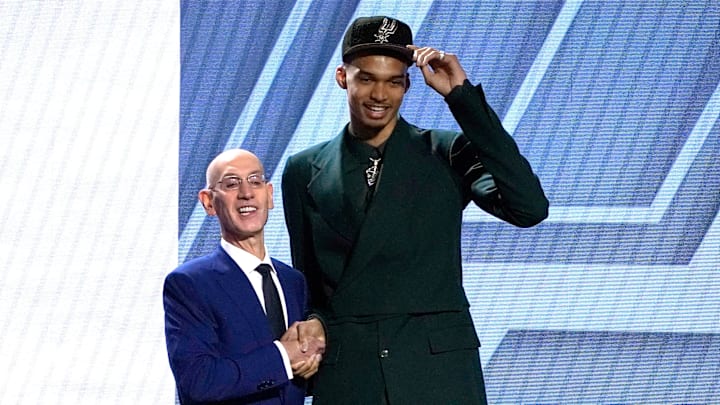In the 2001 comedic masterpiece film "Shrek" the titular character, voiced by Mike Myers, explains to his traveling companion Donkey (voiced by Eddie Murphy) that ogres are like onions. How is that? "Onions have layers" Shrek tells his equine friend.
The NBA Draft is the same way.
For the casual fan, enjoying the NBA Draft is easy. You root for your team to draft the player from your favorite college, and when they don't, you quickly get up to speed on why the player your team actually drafted will be the next Kobe Bryant.
Peel back a layer, and you start to read about draft prospects. Peel back another layer, and you are watching draft breakdown videos and making your own personal rankings. Keep peeling, however, and you get to the good stuff: draft salaries.
It's not merely trivia, but crucial to understanding how teams approach the NBA Draft. The Atlanta Hawks, for example, are likely quite pleased that they leaped up in the lottery to snag the No. 1 overall pick, giving them their pick of any draft prospect. Some part of their front office, however, is likely frustrated that they have to pay a No. 1 overall pick salary for a player who in most drafts would be the sixth pick. Moving up from 10th or 11th to first added around $6 million in salary for this season.
Teams routinely trade up or down the draft board for financial reasons, not prospect talent and fit reasons. A team with two firsts may trade both to move up, reducing the financial cost and getting a better prospect. A team with a massive luxury tax bill may seek to trade out of the first entirely, instead picking up second round picks who count differently against the tax.
How does the rookie scale affect player contracts, and what does that information mean for the teams drafting? Let's break down how the rookie salary scale works and what players at each draft position will make.
What is the NBA Rookie Scale?
The NBA ties many of its salaries directly to the salary cap, including maximum contracts and cap exceptions. The incoming rookie class is no different, as each individual draft slot is locked in at a different salary amount, tied to the salary cap in any given season.
Teams have some flexibility in signing the players they draft, as a player can agree to as little as 80 percent of their rookie scale salary based on the slot they were taken in, and they can negotiate to as much as 120 percent. Most first-round rookies make 120 percent of their rookie scale slot.
For teams hoping to maximize their salary cap flexibility, the rookie scale is not helping them out. Unsigned first-round picks have a cap hold of 120 percent of their rookie scale, meaning that until they are signed they count against the drafting team's salary cap at the same amount they are likely to sign for.
Rookie scale contracts are automatically four-year deals, with two guaranteed seasons and two team options with a trigger date a full calendar year ahead of the season in question. For example, Victor Wembanyama was drafted in 2023, meaning he has a guaranteed contract for 2023-24 and 2024-25, and the Spurs will need to decide on whether or not to pick up his third year by the start of this upcoming season (it seems likely they will pick that option up and keep him around).
Do second round picks work the same?
Second-round picks are actually quite different from first-round pick, in large part because they are not subject to the same type of rookie scale. While the options were limited in past years, the new Collective Bargaining Agreement that began last year opened up a new second round cap exception in order to sign second-round picks.
It used to be that if teams wanted to sign their second-round picks to longer or more lucrative deals they had to open up a contract exception like the Taxpayer Mid-Level Exception and use some of that money. Now teams are automatically provided a "second round exception" when they draft a player in the second round, and they can use that exception to sign a player to a three or four year contract at the minimum.
Teams don't have to use the second round exception to sign a player; they still can use exception money or cap space to sign a player drafted in the second round to a more lucrative contract. Players drafted in the second round also do not count against the cap, allowing teams to conduct the rest of their business and then sign their second-round pick(s).
How much will first-round picks make in the 2024 Draft?
The projected salary cap for the 2024-25 season is $141 million, which then dictates how much each first round pick will make over the course of their rookie scale contract.
For example, the first overall pick is projected to make $10.5 million in the first year of their contract, while the 10th pick will make just $4.5 million and the 30th pick only $2 million.
If the San Antonio Spurs stay put with the No. 4 pick and No. 8 pick, they will pay out $12.8 million combined for those two picks in the first season if they sign for 100 percent of their salary slots. More likely, the Spurs will actually pay $15.4 million if they sign for the expected 120 percent of the rookie scale.
The No. 4 pick will make $9.1 million, $9.5 million, $10.0 million and $12.7 million over the course of their rookie contract, which represents 120 percent of the rookie scale. The No. 8 pick will make $6.28 million in year one, $6.5 in their second season, $6.9 million in the third and $ million in the fourth.
You can find a full breakdown of every draft slot here on Spotrac.
